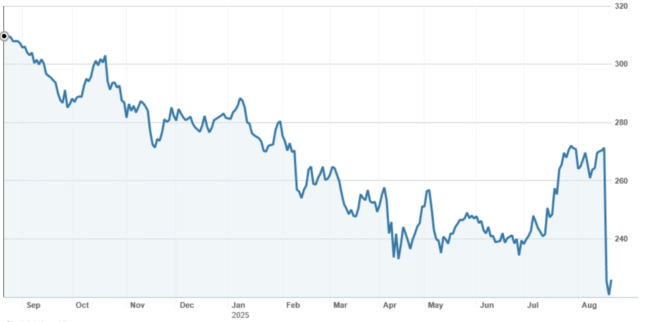CSL’s low last week came about after an underwhelming profit result and outlook. Is it in the buy zone? Or will it stay down? I take a closer at the result and what the market didn’t like and see what the major brokers have to say.
CSL is becoming a stock for the “true believers”. Since the early days of Covid when it threatened to become Australia’s largest company and the share price soared through $340, it has been on a downward slide, unable to sustainably hold above $300 and then last week touching $209. The low came after an underwhelming profit result and outlook, with the stock recovering a touch to finish the week at $216.60.
Is CSL in the “buy zone” or is the rating downgrade permanent? Let’s take a closer look at the result and in particular what the market didn’t like and see what the major brokers have to say.
CSL: profit and outlook
CSL’s full year profit (net profit after tax and amortisation on a constant currency basis) of US$3,303 million was up 14% on FY24 and in line with prior guidance of US$3.2 billion to US$3.3 billion. The market was hoping for a little bit more.
Compositionally, CSL Vifor (the iron deficiency treatment division) did better than expected, with sales up 8% and an operating contribution of US$1,096 million, up 14%. However, the main division, CSL Behring (blood plasma products), only delivered an operating result that was up 9% to US$4,704 million.
The market has been expecting an improved margin for CSL Behring, getting back to the “pre-Covid days” when plasma collection costs were proportionately lower. Although the margin for FY25 of 51% was higher than FY24’s 49.7%, the margin in the second half went backwards on the first half.
Looking ahead, CSL CEO Dr Paul McKenzie guided to overall revenue growth of 4% to 5% in FY26. This was a little lower than FY25’s 5.3% and market expectations. Tender losses in the UK and Mexico, and lower contributions from avian influenza and Covid-19 vaccines, would be offset by robust patient demand for many of the blood plasma products. For earnings, the guidance was NAPATA growth of 7% to 10%, US$3.45 billion to US$3.55 billion at constant currency (excluding restructuring costs). A modest improvement in margin for CSL Behring is expected.
In relation to the profit guidance, Dr McKenzie said: “This guidance assumes no impact from pharmaceutical sector tariffs. It is our current expectation that any such policy would not impact our ability to deliver on the strategic initiatives outlined today. CSL has significant operations in the US and the majority of our commercial portfolio is drug-sourced from there.”
Accompanying the profit result was an unexpected transformation plan. Firstly, CSL plans to demerge the vaccines division (CSL Seqirus) to CSL shareholders as a separate ASX listed company by the end of FY26. Seqirus will be the global number 2 in a US$7 billion vaccines industry, with revenue of US$2.2 billion and an operating result of about US$1 billion. CSL said that the demerger would reduce complexity and make the businesses more agile and efficient to manage, as well as reinvigorating focus on core differentiating capabilities. The rationale was, however, somewhat underwhelming.
Secondly, CSL announced a transformation (cost out) plan to deliver annual savings of greater than US$500m by the end of FY28. This would be achieved by optimising the R&D expenditure with the footprint reducing from 11 sites (globally) to 6 sites, up to a 15% headcount reduction (about 3,000 positions), the closure of 22 underperforming plasma collection centres and streamlining corporate functions. One off pre-tax restructuring costs of US$700 million to US$770 million would be incurred in FY26.
A share buyback is also being re-introduced, with A$750 million of shares to be purchased on market in the next 12 months. This is part of a refreshed capital management plan, which will target a leverage ratio (net debt to EBITDA) of 1.5x to 2.0x (currently 1.8x).
What do the brokers say (now) about CSL?
The brokers have collectively been very wrong about CSL. (I am also in that camp). Not surprisingly, they cut their target prices following the lower-than-expected profit guidance for FY26 (and assumptions about the following years). According to FN Arena, the consensus target price reduced by around $32 and now sits at $282.67, 30.5% higher than Friday’s ASX closing price of $216.60. The table below shows individual target prices and recommendations.

On multiples, the brokers have CSL trading at 20.1 times forecast FY26 earnings and 17.2 times forecast FY27 earnings and paying a prospective yield of 2.3% pa.
Ord Minnett’s take of the result (precis by FN Arena) is a good summary of the negative response to the announcement:
“While CSL’s FY25 result was marginally ahead of market profit expectations, Ord Minnett notes the composition disappointed. The broker points to weakness in immunoglobulin, lost UK tenders, and US Medicare changes weighing on Behring.
Seqirus and Vifor performed better than forecast, but a lower tax rate and interest expenses flattered the bottom line, highlights the analyst.
Ord Minnett has concerns around CSL’s plan to spin off Seqirus by FY26, arguing limited visibility on segment earnings and the absence of pure-play influenza comparables undermines the strategic rationale.
A restructure targeting US$500-550 million of annualised cost savings over three years requires -US$700-770 million in one-off costs. The broker doubts management can achieve the savings and sees sales and marketing investment as more appropriate.
With CSL abandoning its 3-5 year timeline for Behring margin recovery, Ord Minnett sees added uncertainty and complexity in the investment case.
The broker cuts its EPS forecasts by -1-8% for FY26-FY28 and by -12% beyond. Ord Minnett lowers its target price to $258 from $310 and downgrades by two ratings notches to Hold from Buy.”
Morgans was more positive.
“Morgans notes CSL delivered FY25 results broadly in line.
The broker highlights Behring’s softer performance due to Medicare Part D reform in the US and tender timing, though underlying demand remains robust.
Restructuring was the key strategic update, suggest the analysts, with management targeting US$500-550 million in pre-tax savings by 2028, a planned Seqirus demerger, and a US$500 million buyback starting in FY26.
Morgans sees these initiatives as a positive move simplifying the portfolio, sharpening operational focus, and supporting margin expansion.
Vifor grew 8% with margin improvement, while Seqirus fell -9% on weak immunisation rates but is showing signs of stabilisation, suggests the broker.
Although management withdrew its FY27-28 margin timeline, gross margin gains and lower cost/litre initiatives support further improvement, in the analyst’s view.
Morgans makes modest forecast earnings downgrades of up to -2.2% for FY26-27. The target price falls to $293.83 from $303.70 and the broker retains a Buy rating”.
CSL – last 12 months

Source: nabtrade
In an expensive market, CSL looks remarkably cheap (at around 20 times next year’s earnings) for a company growing revenue at 5% and profit at high single digit.
Making a company more efficient is never a bad thing, and while the logic behind the Seqirus demerger is not clear, demergers have a good track record in Australia (often after a slow start) of delivering enhanced shareholder value.
I think the market was too hard on CSL and it’s now in the buy zone. This all said, I’m not sure what the catalyst will be for the market to re-rate CSL, so I think you can be a patient buyer. Maybe the catalyst will come when CSL holds its Capital Markets Day on November 5.

